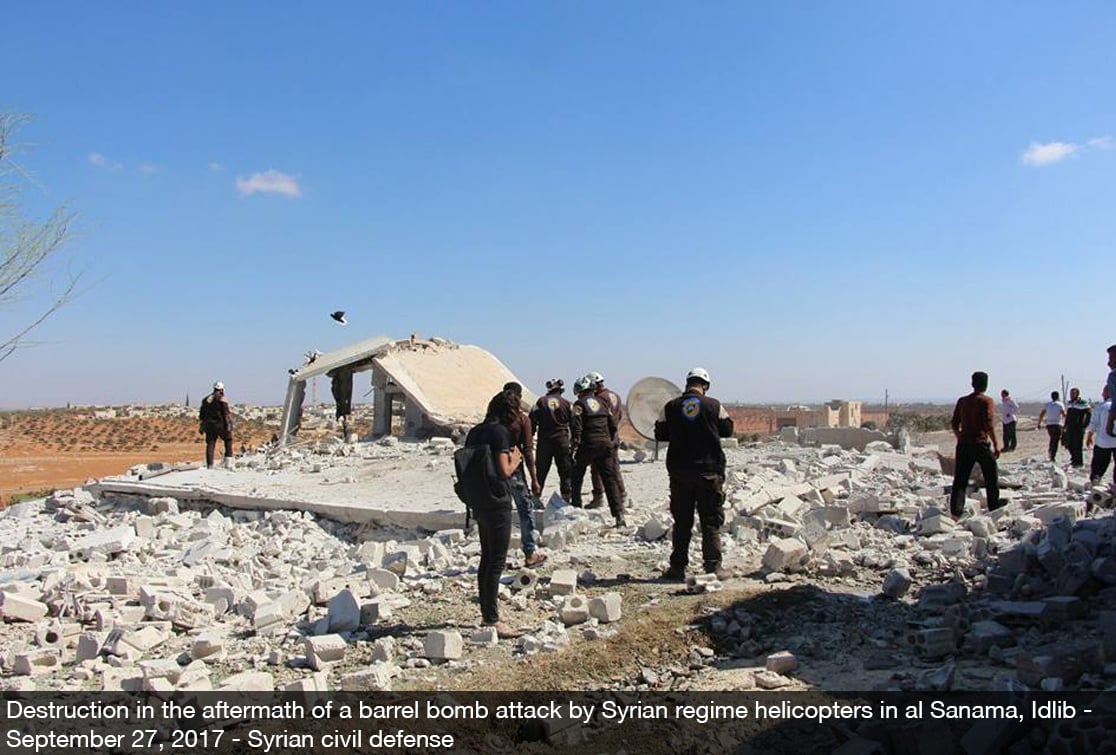The Syrian Regime is Dropping Barrel Bombs in Deir Ez-Zour Governorate again

SNHR has published its monthly report on the use of barrel bombs by Syrian regime forces for the month of September.
The report highlights the de-escalation agreement in Syria, which commenced on May 6, 2017, after it was announced at the end of the fourth round of Astana talks which was held between representatives from Russia, Turkey, and Iran as the states that sponsored Ankara Ceasefire agreement. The agreement outlined four major de-escalation areas, where a cessation of combat operations will take place in these areas, humanitarian aids will be delivered, and IDPs residents will be allowed a return to these areas. These areas, as specified by the agreement, are: Idlib governorate and the surrounding areas (parts of Aleppo, Hama, and Latakia governorates), northern Homs governorate, Eastern Ghouta, and parts of Daraa and al Quneitra governorates in the southern parts of Syria. It was provided that an expert committee would accurately assign the borders of said zones at a later date.
Also, the report briefs that the American and Russian presidents, following an extensive round of talks between Russia, USA, and Jordan that commenced in May 2017 in Amman, Jordan’s capital, announced that a ceasefire agreement has been reached in southwestern Syria – Daraa, Quneitra, and Suwayda governorates on the sidelines of the 2017 G20 summit in Hamburg. The agreement went into force at 12:00 on Sunday July 9, 2017, and provided for the passage of humanitarian aids in addition to a ceasefire between the conflicting parties (Syrian regime forces and their allies on one side, and armed opposition factions on the other side). Also, the agreement specifies that maintaining security in this region is the Russian forces’ responsibility in coordination with the Americans and Jordanians.
Then, the report talks about other local agreements that have been struck, such as Eastern Ghouta between armed opposition factions in Eastern Ghouta and officials from the Russian side, and a similar agreement in northern suburbs of Homs governorate. However, the texts of these agreements haven’t been made public on Russian government’s websites, and the same for armed opposition factions who didn’t publicize these agreements, except for Failaq al Rahman who published the text of the agreement on their official website. At the end of the agreement, according to the copy on Failaq al Rahman’s website, a signature by a Russian sponsor was shown but without an explicit name. This helps, the report notes, the sponsoring Russian side to easily dissolve from these agreements with no subsequent political or legal obligations and repercussions.
A de-escalation agreement was signed, according to the Russian Ministry of Defense, in Egypt’s capital Cairo on Saturday, July 22, 2017, in Eastern Ghouta following a round of talks between Russian military officials and factions from the armed opposition that took place in Egypt’s capital Cairo. The agreement was to come into effect at 12:00 of the same day, while Failq al Rahman joined the agreement after a representative from the faction signed the agreement with a Russian government representative in Geneva city on Wednesday, August 16, 2017, as the agreement established Failaq al Rahman’s and their areas’ inclusion in the agreement, where it was to come into effect at 21:00 of Friday, August 18, 2017.
The report also sheds light on northern suburbs of Homs and southern suburbs of Hama de-escalation agreement which was signed in Cairo on Monday, July 31, 2017 following a round of talks between armed opposition factions in the area and the Syrian regime represented by the Russian government a sponsoring party, as the agreement was to commence at 12:00 on Thursday, August 3, 2017. Most notably, the agreements provided for a full cessation of hostilities between the conflicting parties in the relevant areas -with the exclusion of the areas in which ISIS and Hay’at Tahrir al Sham are present- and for humanitarian aids to enter these areas and for detainees to be released as per the demands of each party as to which detainees are to be released. The report notes that the toll of victims killed by Syrian regime forces and their widespread violations reflect their lack of commitment to the two most recent signed agreements.
The report notes that the included areas have seen a relatively good drop in the rates of killing since the agreements’ commencement in relation to the past months since March 2011. Nonetheless, breaches didn’t stop, mainly by the Syrian regime, who is seemingly the party that would be most affected should the ceasefire go on, and in particular extrajudicial killing crimes and, more horrendously, deaths due to torture, as rates of deaths due to torture didn’t see any changes from the month prior to the commencement of the agreement. This strongly asserts that there is a ceasefire of some sort on the table, but the crimes that the international community -especially the Russian, Turkish, and Iranian sponsors- won’t see are still going on as nothing had changed.
The report adds that with the end of the sixth round of talks in the Kazakhstani capital, Astana, which were held over the course of two days (September 14-15, 2017), a de-escalation zone was established in Idlib governorate and the surrounding areas, as military forces were to be deployed (Russian, Turkish, and Iranian) to monitor the agreement, with the passage of humanitarian aids. However, on September 19, Syrian-Russian alliance started a heavy offensive against Idlib governorate in response to Hay’at Tahrir al Sham’s “Ya Ebadallah Uthbotou” battle. Supported by some opposition faction (The Islamic Turkistani Party, Jaish al Izza, and Jaish al Nukhba), Hay’at Tahrir al Sham started this battle in northeastern Hama governorate. Subsequently, Syrian-Russian alliance expanded the offensive to include the suburbs of Aleppo and Hama governorates and Eastern Ghouta in Damascus suburbs.
The report records that in September, the use of barrel bombs by Syrian regime forces returned to its former rates seen in July according to our records. The Syrian used barrel bombs again in Deir Ez-Zour governorate for the first time in 16 months as part of the Syrian-Russian alliance to defeat ISIS in the governorate.
The report notes that a barrel bomb is a distinctively indiscriminate weapon with huge destructive impact. Therefore, the barrel bomb doesn’t only kill civilians but also terrorizes and displaces residents in light of the destruction it creates. Dropping barrel bombs from warplanes in this savage and primitive manner amount to a war crime. Every barrel bomb dropped is considered a war crime.
Furthermore, the report notes that barrel bombs were used notably for the first time on Monday 1 April 2012 against the residents of Salqin city. Also, the barrel bomb is a locally-made weapon which is used by Syrian regime forces due to the fact that it is costs notably less than missiles and it has a huge destructive impact. Barrel bombs are a distinctively indiscriminate weapon that even if it killed an armed man, this would be an accident as 99% of the victims killed by barrel bombs are civilians, and the percentage of women and children victims varies between 12% to 35% in some cases.
Vitaly Churkin, the former Russian representative to the United Nations, said that the Syrian regime has stopped using barrel bombs. However, the daily monitoring and documentation conducted by SNHR prove, beyond any doubt, otherwise as the Syrian regime continues to kill and destroy Syria by dropping hundreds of barrel bombs.
The report outlines the toll of barrel bombs since the start of 2017, which amounted to 4,784 barrel bombs. Also, the report records that 216 barrel bombs were dropped in September, most of which were dropped in Damascus suburbs, followed by Hama, and then Deir Ez-Zour.
According to the report, these barrel bombs attack resulted in the killing of eight civilians – five children and three women.
The report emphasizes that the Syrian government has, beyond any doubt, violated Security Council Resolution 2139, and used barrel bombs in a widespread and systematic manner and violated, through the crime of murder, Article 7 of the Rome Statute in a widespread and systematic manner as well, which constitutes crimes against humanity. Additionally, the Syrian government violated many rules of the international humanitarian law by perpetrating tens of crimes that amount to war crimes which manifested in the indiscriminate and random bombardment that was also disproportionate due to the use of excessive force.
The report calls on the Security Council to insure the serious implementation of its Resolutions. These Resolutions have become merely words and, thus, the Security Council has lost all of its credibility and purpose.
Also, the report demands that an arms embargo is imposed on the Syrian government, and all those who are supplying the Syrian government with funding and weapon should be prosecuted considering the risk that these weapons might be used to commit crimes and serious violations of human rights.


